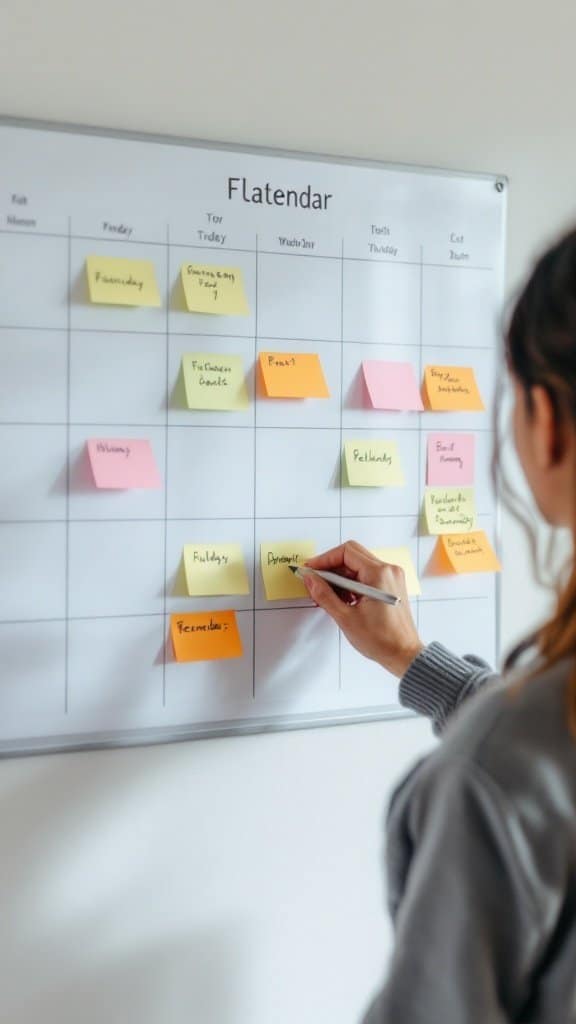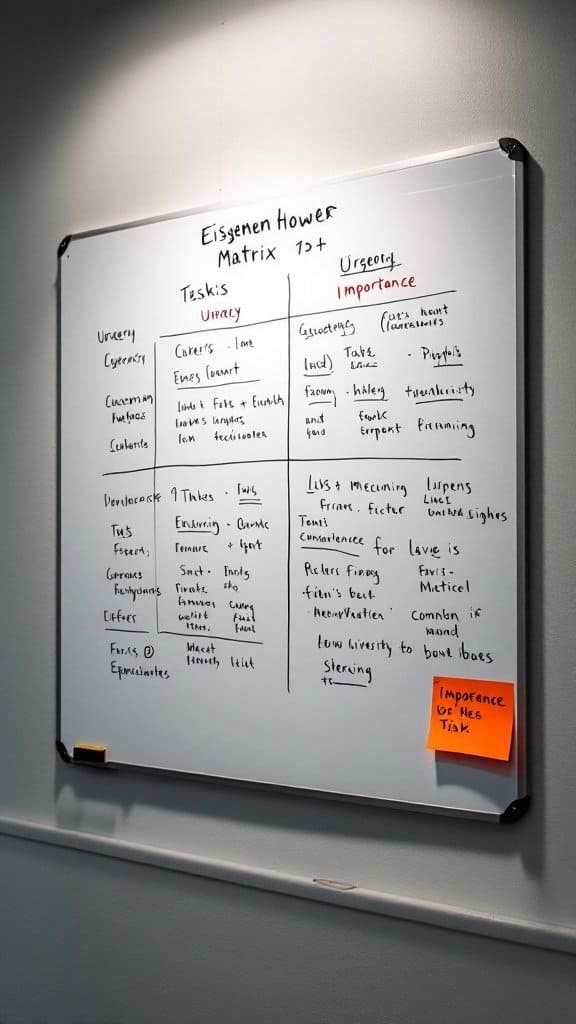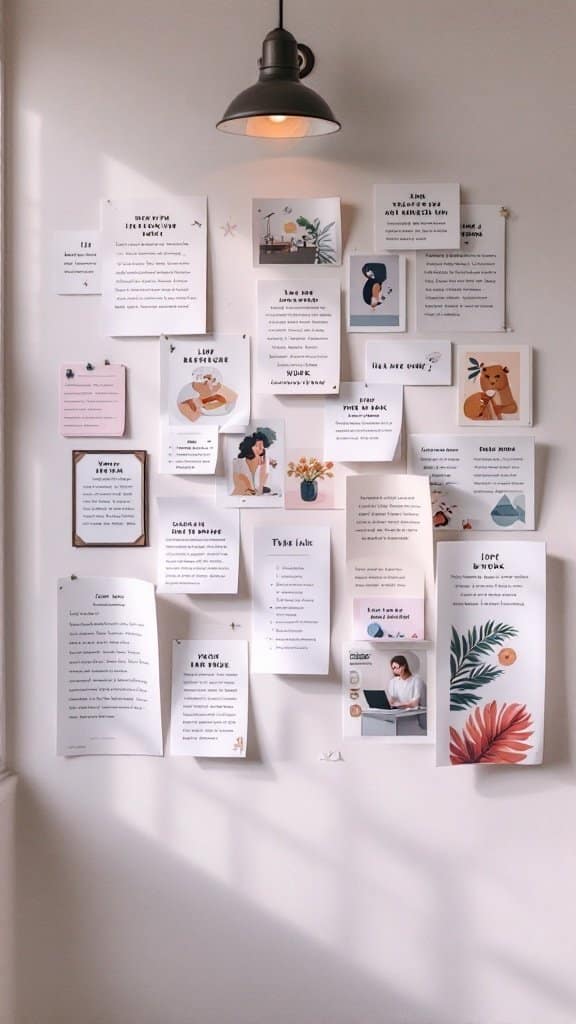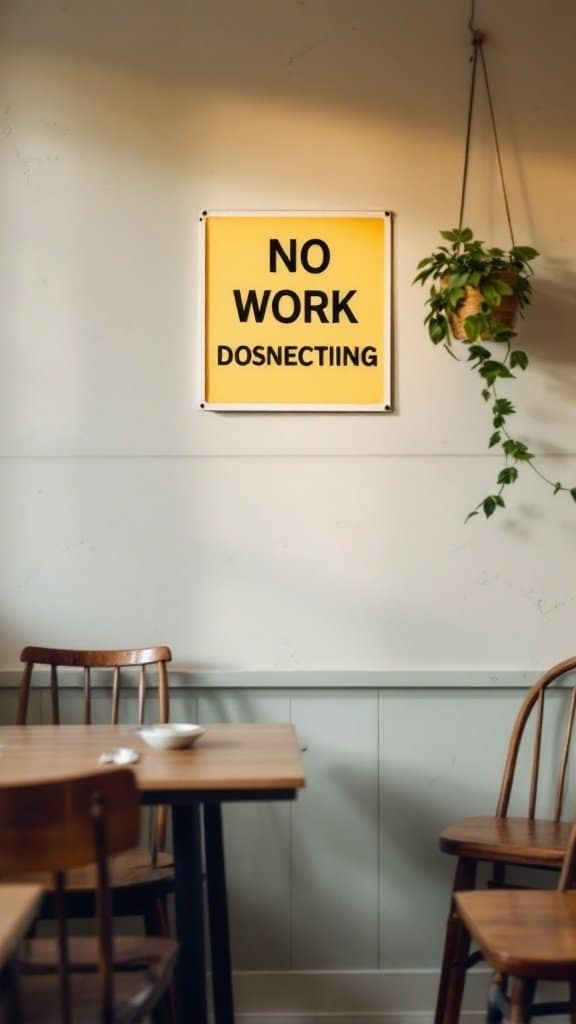Struggling to find the right balance between your work and personal life? You’re not alone. Many people grapple with the constant tug-of-war between deadlines and downtime. That’s why we’ve put together these 15 practical work-life balance hacks that you won’t hear from your boss. Ditch the stress and embrace a healthier routine without compromising your productivity. Let’s dive in!
Establishing a Dedicated Work Space

Creating a dedicated workspace is essential for maintaining work-life balance. The image showcases a cozy, well-organized desk that invites productivity. Notice how the natural light filters in, illuminating the space and enhancing focus.
Plants on the desk add a touch of nature, making the environment feel fresh and alive. Incorporating greenery can reduce stress and improve mood, both important for a productive work session.
On the desk, you can see a stack of books and writing materials neatly arranged. An uncluttered workspace can lead to clearer thoughts and better organization. Having a designated area helps your brain switch into work mode more easily.
Additionally, the presence of a clock reminds you to keep track of time. Balancing work and breaks becomes simpler with a visual cue. A dedicated workspace helps you set boundaries, making it easier to disconnect when the workday is over.
Leveraging Technology for Efficiency

In today’s fast-paced world, technology plays a crucial role in our work-life balance. The image shows a sleek computer screen filled with various apps and tools, illustrating how digital solutions can help streamline tasks. With tools at our fingertips, we can manage our time better and enhance productivity.
Using technology effectively can free up valuable time. For instance, automation tools can handle repetitive tasks, allowing you to focus on what really matters. Notifications from project management apps can keep you organized, ensuring you meet deadlines without feeling overwhelmed.
Your workspace can be a reflection of your efficiency. A tidy desk, complemented by the right tech, creates a calming environment. The glowing lamp and organized setup in the image suggest a space where creativity can thrive, emphasizing the importance of a good work atmosphere.
Integrating video calls and collaboration tools can also facilitate communication, knocking down barriers that might hinder teamwork. This fosters a sense of connection, even when working remotely. So, take advantage of the digital landscape to enhance your workflow and maintain that essential work-life balance!
Setting Clear Boundaries Between Work and Home

In today’s world, where remote work is becoming the norm, it’s easy to let work seep into your home life. This image of a cozy workspace highlights the importance of having a dedicated area for productivity. A clear separation helps you mentally shift between work and relaxation.
Notice how the desk is organized yet inviting, with plants adding a touch of calm. This environment can inspire you to create your own space where work is distinct from your living area. Setting up boundaries—both physical and mental—can lead to better focus during work hours and a more enjoyable home life afterward.
To effectively set these boundaries, try adopting a routine. Start and end your workday at the same time. When you step away from your desk, it signals to your brain that it’s time to relax. Consider using a dedicated workspace, like the one in the image, which can help you associate that spot with productivity.
Additionally, communicate with family or housemates about your work hours. This way, they will understand when you are unavailable. Remember, protecting your personal time is crucial for maintaining balance and avoiding burnout.
Incorporating Breaks for Mental Recharge

In our fast-paced work environment, it’s easy to forget the importance of taking breaks. The image above beautifully illustrates the concept of stepping away from your desk to recharge your mental batteries. It shows a person meditating in a serene outdoor setting, surrounded by nature’s vibrant colors.
Nurturing your mind is essential for maintaining productivity and creativity. When you allow yourself some quiet time, like in the image, you can clear your head and return to your tasks with renewed focus. Even just five or ten minutes of mindfulness can make a difference.
Incorporating short breaks into your workday can help reduce stress and prevent burnout. You might find that stepping outside for fresh air, or simply sitting in a calm space, can enhance your mood and concentration. Just like the person in the image is taking a moment to pause and reflect, you too can find solace in these small moments throughout your day.
Utilizing Time-Blocking Techniques

Take a look at the image of a beautifully organized planner filled with colorful sticky notes. This visual representation highlights a time-blocking technique that can help you streamline your day.
Time-blocking is all about scheduling specific blocks of time for different tasks. By separating your day into dedicated time slots, you can focus on one task at a time. This method reduces distractions and helps you manage your time effectively.
In the image, you can see various colors representing different activities or projects. For example, you might use blue for meetings, pink for personal tasks, and green for focused work. This colorful approach not only adds a fun element but also makes it easy to see how your day is structured.
To get started with time-blocking, grab a planner or even a digital calendar. Decide on the tasks you need to accomplish and allocate specific time slots for each. By visualizing your day, you can make sure to balance work responsibilities with personal time.
Remember to leave some buffer time between blocks to handle unexpected interruptions. This will help you stay flexible while maintaining your structure. As you practice time-blocking, you’ll find it easier to manage both work and life, giving you that balance we all crave.
Practicing Mindfulness and Stress Management

In the hustle and bustle of life, taking a moment to breathe can make a big difference. The image shows a person sitting peacefully in a serene outdoor setting, surrounded by nature. This scene is a perfect reminder of the power of mindfulness and how it can help with stress management.
Mindfulness is all about being present. Instead of worrying about the past or future, focus on what’s happening right now. Just like the person in the picture, find a quiet spot, close your eyes, and take a few deep breaths. Feel the air around you and let your thoughts drift away.
Stress management is crucial for maintaining a healthy work-life balance. When you practice mindfulness, you create space for relaxation and clarity. This doesn’t have to be a big commitment. Just a few minutes a day can help you feel more centered and less overwhelmed.
Incorporating simple mindfulness techniques into your daily routine can be as easy as taking a walk in nature, like the setting in the image. Pay attention to the sounds, the colors, and the scents around you. These small practices can greatly improve your overall well-being and help you tackle daily challenges with a clearer mind.
Creating a Flexible Work Schedule

Have you ever felt overwhelmed by your workload? It’s a common struggle, and finding a flexible work schedule can help ease that stress. The image above shows someone planning their week with colorful sticky notes on a whiteboard calendar, known as a “flatendar.” This visual tool can be a great way to organize tasks and commitments.
Using a flatendar allows you to see everything at a glance. You can prioritize urgent tasks while also setting aside time for personal activities. This balance is key in maintaining your work-life harmony. By keeping things organized, you can make quick adjustments as needed, ensuring that your schedule works for you.
Try assigning different colors for various types of tasks. For example, use one color for work-related projects and another for personal errands. This approach not only adds a bit of fun but also helps you visualize your commitments. You’ll be surprised at how much easier it is to manage your time when you make it visible.
Don’t hesitate to communicate with your boss about your flexible schedule needs. Many workplaces are becoming more accommodating, and discussing your requirements can lead to positive changes. Remember, a little planning goes a long way in helping you achieve that much-needed balance.
Prioritizing Tasks with the Eisenhower Matrix

The Eisenhower Matrix is a simple yet effective tool to help prioritize tasks based on urgency and importance. The image shows a whiteboard filled with tasks categorized into four quadrants. This visual guide makes it easy to see what needs immediate attention and what can wait.
The top left quadrant focuses on tasks that are both urgent and important. These are the items you should tackle right away. The top right quadrant contains tasks that are important but not urgent, which is where you can plan effectively. The bottom left quadrant lists urgent tasks that are not particularly important, which can often be delegated. Finally, the bottom right quadrant includes tasks that are neither urgent nor important—these can be eliminated or postponed.
Using the Eisenhower Matrix as a daily practice can help clear your mind and reduce stress. It encourages you to focus on what truly matters rather than getting lost in a whirlwind of tasks. If you find yourself overwhelmed, taking a moment to categorize your tasks can provide clarity and direction.
Practicing Gratitude to Boost Positivity

In our busy lives, taking a moment to pause and reflect can make a big difference. The image above shows a cozy scene with a warm cup of tea and an open notebook filled with handwritten notes. This setup invites feelings of calm and encourages us to practice gratitude.
Writing down what we’re thankful for can shift our focus from stress to appreciation. It’s simple but effective. When we note down positive experiences, it helps us recognize the good in our day-to-day lives. This practice can enhance our overall mood and make us more resilient during challenging times.
Imagine sipping your tea while jotting down three things you appreciate. It could be anything from a supportive friend to a beautiful sunset you witnessed. Regularly doing this can create a habit of looking for positivity, even on tough days.
Moreover, gratitude isn’t just about listing items; it’s about feeling the joy that comes with them. When we actively engage with these thoughts, we allow ourselves to cultivate a more positive mindset. So why not grab a notebook and start your own gratitude practice? You might be surprised at how much it can brighten your outlook!
Scheduling Regular Check-Ins with Your Manager

In today’s work environment, staying connected with your manager is important for maintaining a healthy work-life balance. The image here shows a virtual check-in between two colleagues. This kind of interaction can make a big difference in how you manage your tasks and responsibilities.
Regular check-ins allow you to discuss your workload, share any challenges, and celebrate your successes. This open line of communication can help you feel supported and understood. Instead of waiting for formal reviews, these casual chats keep the dialogue going.
Think of these meetings as a chance to align your goals with your manager’s expectations. You can express any concerns about workload or deadlines, and discuss ways to adjust your work if needed. This proactive approach can help reduce stress and increase your overall satisfaction.
Moreover, having these scheduled check-ins can lead to better time management. You’ll feel more connected to your projects, which makes it easier to prioritize your tasks and maintain a healthy balance between work and personal life.
So, don’t hesitate to set up regular check-ins with your manager. It’s a simple yet effective way to enhance your work experience and keep everything on track!
Finding Support Through Networking

Networking can be your secret weapon for achieving a better work-life balance. The image above captures a lively gathering of professionals in a well-lit space, surrounded by greenery. This setting isn’t just about socializing; it’s about building connections that can support you in your career.
When you engage with others, you open doors to new opportunities. Whether it’s sharing tips, exploring new ideas, or simply lending an ear, every interaction counts. These connections can provide emotional support during busy times or help you navigate workplace challenges.
Think about attending local events or joining online groups. Don’t hesitate to reach out to colleagues and industry folks; you never know who might have valuable insights. Remember, networking isn’t just for job hunting. It’s about creating a support system that can enhance both your professional and personal life.
Taking Advantage of Remote Work Perks

Imagine working on a beach, the sound of waves in the background, and a gentle breeze keeping you cool. This image captures a moment many of us dream about: someone typing away on their laptop while sipping coffee and enjoying the scenery. Remote work opens up a world of possibilities, allowing you to blend work and relaxation in ways that traditional office settings simply can’t offer.
One of the key advantages of remote work is the flexibility it provides. You can choose your workspace—whether that’s a cozy café, a library, or a beautiful beach. This flexibility can lead to increased productivity. When you’re comfortable and in a setting you love, work often feels less burdensome. Plus, you can adjust your work environment to suit your mood.
Another perk is the potential for better work-life balance. By taking advantage of remote work, you can schedule your tasks around personal commitments, family time, or even a spontaneous trip. This allows for a more fulfilling lifestyle where work doesn’t consume all your time and energy.
Lastly, don’t forget about the cost savings that come with remote work. You can save on commuting costs, work attire, and meals. Why not use those savings to treat yourself to a little getaway? All these perks create a more enjoyable work experience that can enhance your overall happiness.
Setting Personal Goals Outside of Work

Have you ever felt like your job takes over your entire life? It’s easy to get caught up in work and forget about personal goals. The image above captures a cozy wall filled with inspiration. Each note and picture is a reminder that life is more than just deadlines and meetings.
This visual represents the importance of setting personal goals outside of work. These goals can help you find balance and joy. Whether it’s a new hobby, fitness objectives, or simply making time for friends, having clear personal goals adds meaning to your day.
The notes on the wall suggest various activities and reminders. They encourage you to explore passions that may have been pushed aside. Think about what brings you happiness and write it down. This can be a great way to kickstart your journey toward a more fulfilling life.
Incorporating personal goals into your routine is a great hack for work-life balance. They act as a counterweight to work stress. So, take a cue from the image—create your own inspiration wall and start jotting down goals that excite you. You’ll not only feel motivated but also create a better blend of work and life.
Engaging in Hobbies for Personal Fulfillment

Have you ever noticed how a little creativity can brighten your day? In the image, a woman is happily painting in a lush, sunlit space filled with vibrant flowers. This scene perfectly captures the joy that comes from engaging in hobbies. It reminds us that taking time for ourselves is vital for our well-being.
Hobbies are more than just activities; they’re pathways to personal fulfillment. When you dedicate time to a passion, like painting, gardening, or even cooking, you step away from work stress and dive into something that brings you joy. This transition can help clear your mind and boost your mood.
Imagine leaving your desk behind and immersing yourself in a project that excites you. Whether it’s picking up a paintbrush or strumming a guitar, these moments help recharge your batteries. You’ll find that those creative outlets can spark new ideas and perspectives, making you more productive when you return to work.
Plus, hobbies give you a chance to express yourself. They allow you to explore your interests and develop skills outside of your job. So, why not take a cue from the woman in the picture? Find something you love and make it a part of your routine. Your work-life balance will thank you!
Implementing ‘No Work’ Zones

Creating ‘No Work’ zones in your life can be a refreshing way to recharge. The image shows a cheerful yellow sign that boldly states, ‘NO WORK,’ serving as a reminder that some spaces are meant for relaxation and enjoyment.
These zones can be anywhere—from your kitchen table to a cozy corner in your living room. The idea is to designate specific areas where work is off-limits. This helps you separate your personal life from your professional duties, which is essential for a healthy work-life balance.
The sign in the picture highlights the importance of ‘not networking’ in these zones. When you’re in a ‘No Work’ area, you should focus on unwinding rather than stressing over emails or deadlines. Think of it as a sacred space that encourages mindfulness and presence.
So, whether you sip your coffee, read a book, or enjoy a chat with friends, let that space be free from work distractions. It’s all about creating boundaries that enhance your overall well-being.
This post may contain affiliate links which means I may receive a commission for purchases made through links. I will only recommend products that I have personally used! Learn more on my Private Policy page.